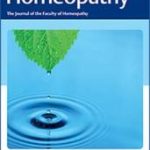Jean-Claude Karp, Carole Sanchez, Philippe Guilbert, William Mina, Antoine Demonceaux, Hervé Curé
Treatment with Ruta graveolens 5CH and Rhus toxicodendron 9CH may reduce joint pain and stiffness linked to aromatase inhibitors in women with early breast cancer: results of a pilot observational study
Homeopathy, 2016, 105 (4), 299-308

Objective – To determine the possible effect of two homeopathic medicines, Ruta graveolens 5CH and Rhus toxicodendron 9CH, in the prevention of aromatase inhibitor (AI) associated joint pain and/or stiffness in women with early, hormone-receptor positive, breast cancer.
Methods – This prospective, unrandomized observational study was carried out between April and October 2014. Women were recruited in two groups, according to which of the two study centres they attended: one receiving homeopathy in addition to standard treatment (group H) and a control group, receiving standard treatment (group C). All women were treated with an AI. In addition, women in group H also took Ruta graveolens 5CH and Rhus toxicodendron 9CH (5 granules, twice a day) up to 7 days before starting AI treatment. The homeopathic medicines were continued for 3 months. Demographic and clinical data were recorded using a self-assessment questionnaire at inclusion (T0) and 3 months (T3). Primary evaluation criteria were the evolution of scores for joint pain and stiffness, the impact of pain on sleep and analgesic consumption in the two groups after 3 months of treatment.
Results – Forty patients (mean age 64.9 ± 8.1 years) were recruited, 20 in each group. Two-thirds of the patients had joint pain before starting AI treatment. There was a significant difference in the evolution of mean composite pain score between T0 and T3 in the two groups (−1.3 in group H vs. +3.4 in group C; p = 0.0001). The individual components of the pain score (frequency, intensity and number of sites of pain) also decreased significantly in group H. Nine patients in group C (45%) vs. 1 (5%) in group H increased their analgesic consumption between T0 and T3 (p = 0.0076). After 3 months of treatment, joint pain had a worse impact on sleep in patients in group C (35% vs. 0% of patients; p = 0.0083). The differences observed in the evolution of morning and daytime stiffness between the two groups were smaller (p = 0.053 and p = 0.33, respectively), with the exception of time necessary for the disappearance of morning stiffness which was greater in group C (37.7 ± 23.0 vs. 17.9 ± 20.1 min; p = 0.0173).
Conclusion – These preliminary results suggest that treatment with Ruta graveolens 5CH and Rhus toxicodendron 9CH may decrease joint pain/stiffness in breast cancer patients treated with AIs. A larger-scale randomized study is required to confirm these results.






Lascia un commento
Devi essere connesso per inviare un commento.